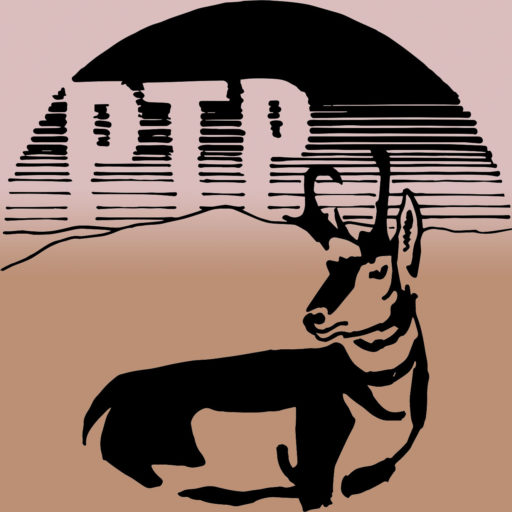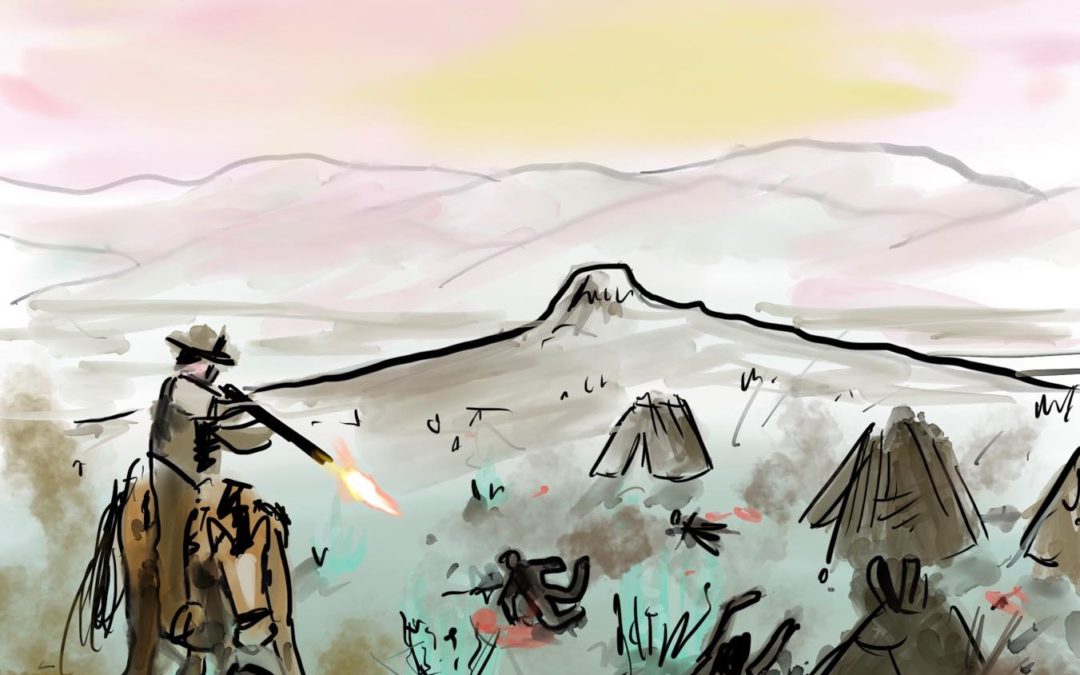What we mean when we say “massacre”
(Reflecting on the September 12, 1865 Thacker Pass Massacre)
Words can, of course, be dangerous. That’s why we keep some words tightly wrapped and shoved into the darkest, coldest corners of our minds. We stuff the realest meanings of other words into the tightly-packed, contained, superficial space created by their letters. Then, we do our best to forget words are so much more than the sum of their letters.
Other words we simply cannot face. So, when we sense them pushing their way through our consciousness, we turn to whatever mindless entertainment, chemical, or other distraction we can find to fling that word, and what it really means, as far from our conscious mind as we can.
Massacre is a word I was running from.
I ran from it as part of my legal work for Thacker Pass. Don’t get me wrong, I used the word over and over again. I used it to try to convince the judge that digging up a massacre site would harm the descendants of those who were massacred. I used it to show the historical and cultural significance of Thacker Pass. I used it to try to protect Thacker Pass.
But, legal words are abstract. Lawyers don’t ask a judge to stop a corporation from digging up someone’s ancestors, they “move the court for a preliminary injunction.” Lawyers don’t call bullshit, they “object to counsel’s characterization of the facts in the case.” Lawyers don’t say it’s simply wrong for rich people to destroy a beautiful mountain pass for more money, they “contend that the defendants’ failure to observe the procedure specified in the National Historic Preservation Act is grounds for revocation of the Record of Decision.”
Despite practicing law for nine years, I never truly understood why legal language is so abstract. Then, the word “massacre” caught me in the middle of the night. The realest meaning of the word massacre ripped through the eight letters confining it, stripped off the layers of denial I had wrapped her in, and forced me to gaze at her full meaning.
Earlier that day, I was working on legal writing describing evidence of the September 12, 1865 Thacker Pass massacre. The last few paragraphs I wrote were:
“The new evidence of the September 12, 1865 Thacker Pass massacre makes it virtually certain that Paiutes were murdered on the east edge of the project area. Lithium Nevada’s proffered map places the remains of the Indian camp just outside the east boundary of the project area. The Sackett account and the Owyhee Avalanche article describe soldiers attacking the Paiute camp from the east, making it most likely that Paiutes fled west towards the project area. The Owyhee Avalanche article describes soldiers chasing Paiutes “over several miles of ground for three hours.” Ox Sam’s account also suggests that Paiutes fled towards the project area. He said he rode to Disaster Peak which is west and north of Thacker Pass. Riding to Disaster Peak would have most likely taken Ox Sam through the whole project area. If the Paiutes ran away from the soldiers over several miles of ground, towards Disaster Peak, as the evidence indicates, then slain Paiutes were most likely scattered across the project area.
The Owhywee Avalanche article also says that soldiers searched amongst the sage and found thirty-one dead. The writer of the article stated: “More must have been killed and died from their wounds, as a strict search was not made, and the extent of the battlefield so great.” Deputy US Surveyor Palmer, three years after the massacre, wrote that, “There are many Indian skulls and other remains to be found scattered over this portion of the Township.”
If “a strict search was not made” for slain and wounded Paiutes, then it seems unlikely that the soldiers buried those they killed. And, if the soldiers did not bury those they killed, then the bones from the Paiute bodies scattered across the project area were almost certainly scattered even farther across the project area by animal scavengers and natural forces like wind, rain, and snow.”
I mistook the antsy anxiety I felt while writing those last few lines about Paiute bodies being scattered across the project area as simply an indication that I had been working for too long and it was time to take a break. With the slight nausea in my gut and the restlessness in my muscles that always accompanies anxiety for me, I saved the document on my computer, shut my it, and moved on to dinner, my evening walk, and bed.
***
Sometime in the very early morning, thundering hoofbeats stirred me. I felt the chilly September air on my face and tried to pull my rabbit blanket over my head. But, the hoofbeats hadn’t stopped. Men began yelling in a strange language. Then, the criss-crossing willow branches I had used to construct the frame of my house began snapping. My eyes flicked open. As my eyes tried to focus on the moonlight pouring through the broken branches, I heard the crack of cavalry carbines and screams over the sound of cracking wood.
The baby! I thought. I turned to where my wife was cradling her. She sleeps heavy, but how does she sleep through this? My hands came back covered in blood. The wall on her side was completely mangled from gunfire.
The baby was wailing. I cradled her in my arms, doing my best to shield her. More branches snapped and pain exploded in my ribs and spine.
Then, I truly woke. My mind pulled me from the nightmare into present reality. I laid there for a long time wondering what it would be like to go from falling asleep at a camp with my family and friends to waking up to the sounds of them being murdered all around me to my own death in a matter of seconds.
If this ever happens to me, I prayed, spare me the waking.
***
The next morning, I opened my laptop back up to begin another day of legal writing. For several hours, I struggled to describe, in legal language, why mechanically digging long trenches through the massacre site would cause my clients “sufficiently specific irreparable harm.” This required me to convince the judge that there are human remains in Thacker Pass. So, I tried to explain, based on the contemporary accounts of the massacre, why the massacre probably extended into the mine project area. I attempted to line up the Bureau of Land Management’s GIS data with a map of the areas they planned to dig up first.
But, I couldn’t find the words. Not after I had been given a glimpse of what the word massacre truly means.
I was stuck. The judge had already ruled that she didn’t think the archaeological digs would harm my clients and that she didn’t think there was sufficient evidence to conclude that there are human remains in Thacker Pass. How could I get her to reconsider? How could I convince the judge to let my client’s ancestors who were brutally massacred in Thacker Pass rest in peace?
A braid of sweetgrass I had absent-mindedly left on a table in the room I was working in caught my attention. Then, I remembered the People of Red Mountain grandmothers telling me to burn sweetgrass when I was feeling anxious or not sure what to do.
So, I did. And, this was the writing that came to me:
“Adult human skeletons are typically composed of 206 bones. Bullets, rifle butts, and knives shatter bones. So, consider an adult Paiute woman waking up in the middle of the night to hear galloping hooves and cracking rifles. Bullets tear through the willow branches she built her wikiup with. Her baby is screaming. She picks him up and flees west away from the soldiers (and into what 160 years later will be the Thacker Pass lithium mine project area.) She sees her brother – the man she would never live to see white people name “Ox Sam” – jump on a horse and gallop towards Disaster Peak.
Through sheer panic and adrenaline, she sprints faster and farther than she ever has before, but she does not sprint fast or far enough. After a few hundred yards, a bullet strikes her baby’s head held against her chest, shattering her baby’s skull before shattering her clavicle and showering the ground with bone shards. So begins only one of dozens of instances of bones being scattered throughout Thacker Pass on September 12, 1865.
The bullet’s impact knocks the dead infant from her arms. Dazed and moaning with pain, she stumbles on for another hundred yards before her moaning attracts the attention of a soldier. She collapses. The soldier approaches her with his revolver and pukes at the sight of her mangled shoulder. Then, he puts his gun to her forehead, pulls the trigger, and the woman’s skull explodes into pieces sprayed across the sage.
A few hours after the shooting stops, the scent of so much spilled blood attracts coyotes. A mother coyote finds the baby’s remains, recognizes that this human baby will be easier for her young to eat than the adult humans, and drags the baby off to her young. Other coyotes pull apart the baby’s mother as they feed. Many of her bones, after being picked clean, are left in Thacker Pass. Over the years, rain and snow create mud in Thacker Pass and gravity drives the bones into the earth until they are no longer observable to a simple surface inspection.”
***
Now, I’m not sure if this writing will make the final draft of the motion I’m still working on. But, I learned why legal language is so abstract. Law is written and controlled by the rich and powerful. In today’s dominant culture, the rich get rich and the powerful get powerful by exploiting the land and colonized peoples. So, today, law protects the exploitation of the land and enables colonization.
The rich and powerful know words can be dangerous. They know that making legal language abstract makes it more difficult for non-lawyers to understand law and therefore makes it more difficult for non-lawyers to understand how the rich get rich and the powerful, powerful. They’d prefer if we never recalled the atrocities they’ve committed – atrocities like massacres. But, if we do recall massacres, they definitely do not want us to consider what a massacre truly is or truly felt like. Because if we do, and we open ourselves to ponder the horrors the rich and powerful have perpetrated, we might find the motivation to stop them.
#ProtectPeeheeMuhuh #ProtectThackerPass
Art by Trav London.


Will, perhaps helpful for un-abstracting the word and it may help sound impressive in court or legal stuff, the following is from Online Etymological Dictionary, http://www.etymonline.com
“massacre (n.) “unnecessary, indiscriminate killing of human beings,” sometimes also applied to wholesale slaughter of animals, 1580s, from French massacre “wholesale slaughter, carnage,” from Old French macacre, macecle “slaughterhouse; butchery, slaughter,” which is of unknown origin; perhaps related to Latin macellum “provisions store, butcher shop,” which probably is related to mactāre “to kill, slaughter.””
be well…..